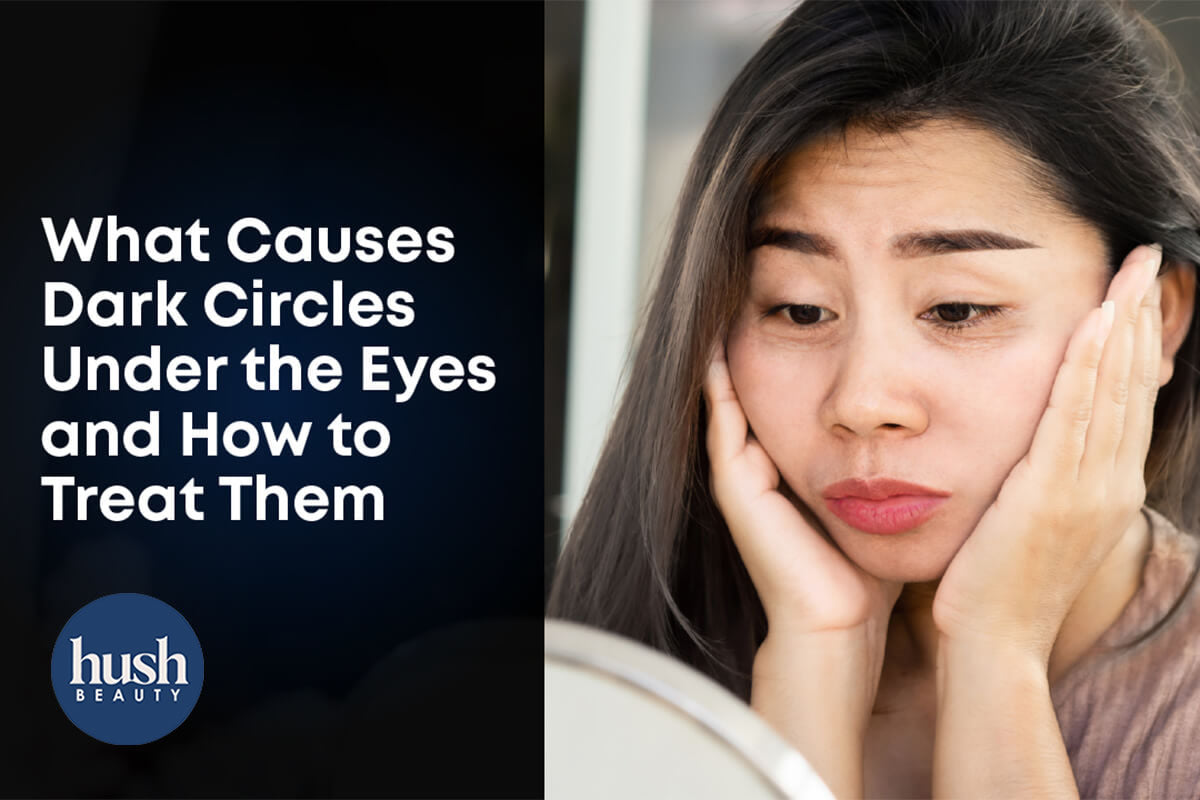What Causes Dark Circles Under The Eyes And How To Treat Them
What Causes Dark Circles Under The Eyes And How To Treat Them

Have you recently looked in the mirror and noticed that you’re looking slightly more tired than usual? Or maybe you noticed the dark circles under your eyes have become more prominent. If so, you’re not alone. Millions of men and women alike have had to deal with the pesky dark circles that can occur under your eyes, often leaving you wondering what causes dark circles under the eyes and how to get rid of them.
Fortunately, treatments are available to help reduce the appearance of dark circles and to help restore a healthy, youthful appearance. However, before diving into treatments, it’s essential to understand what causes these dark circles under your eyes in the first place. Only then can you work with a skilled practitioner to determine your best treatment plan.
What Are Those Dark Circles Under Your Eyes?
Dark circles under the eyes can be a source of frustration for many. They can make you look older and tired, despite getting the recommended amount of sleep. They can also be a source of self-consciousness.
Dark circles aren’t something to be ashamed of. In fact, they are most often associated with the natural aging process. The skin under your eyes can become thinner with age, and the blood vessels under your eyes become more prominent, resulting in dark circles. However, some types of dark circles can be indicative of other underlying conditions.

There are four common types of dark circles that estheticians and cosmetic specialists come into contact with:
- Type 1: these under-eye circles have a bluish tone and can indicate sleep deprivation, allergies, and stress.
- Type 2: these circles have a darker brown, sometimes black, tone and are most associated with sun damage and the natural aging process.
- Type 3: these purplish toned circles under the eyes are usually caused by visible blood vessels, which can result from heredity or lifestyle factors such as sun exposure.
- Type 4: these are more shallow-appearing circles and are typically caused by the natural aging process, causing the skin to thin.

What Causes Dark Circles Under the Eyes?
While many factors, including genetics, allergies, and medical conditions, can cause dark circles, studies are still being done to determine the exact cause of dark circles, and some factors have been identified as potential causes, including:
- Allergies: Allergens cause congestion in the blood vessels under the eyes, causing the blood to pool under the skin. This creates a dark discoloration under the eyes.
- Dehydration: If you don’t keep your body well hydrated, it causes the skin to become dull and can lead to the eyes looking more tired.
- Fatigue: Lack of sleep can cause dark circles under the eyes because it triggers the body’s stress response, which causes the blood vessels to dilate and the area under the thin skin of your eyes becomes darker.
- Genetics/Aging: Dark circles can be hereditary, and as we age, our skin loses its elasticity and becomes thinner. This results in more translucent skin, making the vessels underneath more visible. As we age, we also lose collagen and volume in this area, leading to a more hollow-looking undereye area.
- Hyperpigmentation: This is a darkening of the skin that many factors, including sun exposure, age, and hormones, can cause.
- Lifestyle Choices: Poor lifestyle choices such as drinking alcohol and smoking can lead to darker circles under your eyes thanks to several factors, including dehydration and increased toxins and free radicals in the blood, which can damage the skin and cause it to darken.
- Stress: Stress causes the blood vessels under the skin to dilate, resulting in dark circles under your eyes.

At-Home Care and Treatment for Dark Circles Under the Eyes
When researching how to remove dark circles under your eyes, you’ll find many options available, including preventative measures that you can take to avoid the dark circles from developing in the first place. A few of those tips include:
Getting Enough Sleep
Getting enough sleep is one of the most important things you can do to help prevent dark circles from forming. Lack of sleep can lead to dehydration and a decrease in collagen production, which can cause the skin under your eyes to become thin and fragile.

Cold Compresses
A cold compress can be a great way to eliminate dark circles under the eyes. The coldness helps constrict blood vessels, making the darkness less visible. Plus, it can reduce inflammation and puffiness and promote lymphatic system drainage.
Staying Hydrated
Proper hydration is essential for the skin’s health surrounding the eyes, as dehydration can lead to the thinning of the skin and the appearance of dark circles under the eyes. Hydration helps to maintain the skin’s natural elasticity, allowing it to remain healthy and prevent the formation of dark circles. It also helps reduce inflammation and puffiness around the eye while promoting lymphatic system drainage.

Wearing Appropriate Sun Protection
Finally, you want to ensure you are adequately protecting the delicate skin of the face. This can be done by wearing broad-spectrum sunscreen daily and a hat to protect the face from the sun and damaging UV rays.
Clinical Treatments for Dark Circles Under the Eyes
While many things can be done to help reduce the appearance of dark circles under the eyes, several clinical treatments are available to help you improve the look and feel of the skin surrounding your eyes.

Medical-Grade Skincare
Yes, many over-the-counter skincare products on the market claim to help reduce the appearance of dark circles under the eyes. However, medical-grade skincare products contain higher concentrations of active ingredients proven to help improve the skin. A few of the most common products the team at Hush Beauty Anti-Aging and Skin Care Centre recommends include:
- ZO Intense Eye Creme
- ZO Eye Brightening Repair
- ZO growth factor eye serum
- TNS Eye Repair
- TNS Illuminating Eye Cream
- Uplifting Eye Serum
- Skinceuticals AGE eye complex
- AnteAGE MD eye serum
HydraFacials®
HydraFacials® is a type of facial treatment that combines cleansing, exfoliating, and hydrating ingredients to help reduce the appearance of dark circles around the eyes. The ingredients in HydraFacials brighten and even out skin tone, making it appear more youthful and vibrant. The treatment helps to improve circulation in the area, which can help reduce puffiness and dark circles.
Microneedling
Microneedling is a minimally invasive skin-care treatment that uses tiny needles to create micro-punctures in the skin to activate the body’s natural healing process. This helps to stimulate collagen and elastin production while also increasing circulation and cell turnover of the treated area, resulting in smoother, brighter skin. Combining Microneedling with stem cell derived brightening serum will enhance the results even further.
Fillers
Finally, if your dark circles are caused by volume loss, injectable fillers could help lift and fill out the under-eye area. This helps to reduce the shadows that often make the skin appear darker than it is.
Chemical Peel
A Chemical peel is a tremendous treatment for skin rejuvenation. It can be used for a myriad of skin concerns like hyperpigmentation, poor skin quality due to environmental damage and aging, acne scarring, lines and wrinkles, skin laxity, sagginess and collagen loss. Customizing the depth of the peel with the right solution will give phenomenal results that can rival almost any skin rejuvenation treatments out there.
Treating Dark Circles Under the Eyes at Hush Beauty Anti-Aging and Skin Care Centre
While the appearance of dark circles under the eyes may feel like an unavoidable part of life, several options are available to help treat and reduce their appearance. First, sit down with Dr. Rose Wong and discuss what might work best for your unique situation.
Dr. Wong believes that patient education is crucial in successfully treating under-eye circles. She understands that no two people are the same and will tailor your treatment plan to your needs and desired results, and a big part of that is educating you on what may be causing your dark circles and what treatments are most suitable.


